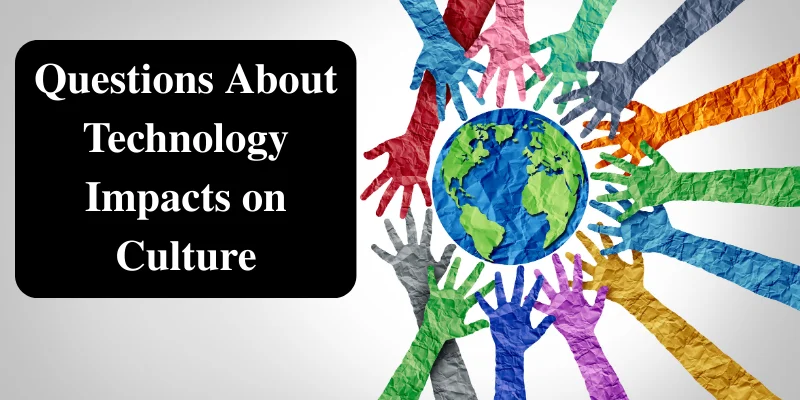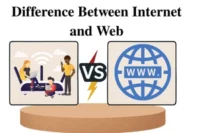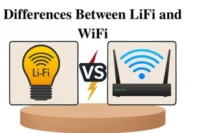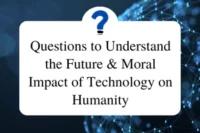11 Questions on How Technology Impacts Culture & Relationships With Detailed Answers
Published: 3 Sep 2025
Technology is transforming the way we interact with one another and our experience of the world. In 2025, its impact on culture is more apparent than ever. We can now communicate rapidly, but this leads to new kinds of issues.
While technology can bring people closer together, it can also reduce physical contact and create disparities between those who have access to digital tools and those who do not.
How does technology shape teenage culture today? How is it changing the way we socialize and connect with society? The following are the questions we will address in this article. By exploring the latest technological trends, we’ll highlight both the positive and negative aspects of our digital environment.
This article will explain how technology influences your daily relationships and culture. Whether you’re interested in its impact on art or social behavior, we will provide clear, practical advice to help you understand the digital world.

Questions About How Technology Impacts Culture & Relationships
Here are some trending questions on technology impacts on our relationships and cultures.
1. How does technology impact our relationships today?
Technology has made communication faster and easier, enabling people to stay connected across distances.
People can now connect in real-time, regardless of their location, thanks to technologies such as instant messaging and video calls. However, it has also resulted in fewer face-to-face interactions, which can lead to emotional distance.
Example: Social media platforms such as Facebook, Instagram, and WhatsApp enable people to maintain friendships and relationships with relatives; however, excessive use can lead to feelings of loneliness.
2. How does technology impact teenage culture?
Technology is deeply rooted in teenage society, influencing everything from social interaction to entertainment.
Teenagers use smartphones and social media to express themselves and connect with other young people. Digital Technology enables individuals to connect with global trends, cultures, and online communities, all of which shape their identities and perspectives. It also entertains us through online games and video streaming.
Example: The digital world also comes with risks, such as online harassment, addiction to digital platforms, and mental health concerns related to social media’s impact on self-confidence.
3. How does technology affect art?
Technology has revolutionized the art world, offering artists new tools and platforms for creation and distribution.
Digital art, virtual reality, and interactive setups have expanded the possibilities for innovation. Artists can now create works that challenge traditional standards while reaching a global audience through social media and online galleries.
Example: Technology has empowered the art industry, enabling aspiring artists to showcase their work online through social media platforms like Instagram, Facebook, and YouTube.
4. How does technology impact culture and society?
Technology has profoundly impacted both culture and society by changing the way we work, live, and interact.
It has facilitated globalization by enabling various civilizations to communicate and exchange ideas. It is also helping the creation of new communities, thanks to platforms like Twitter and Instagram, where individuals can express their views.
5. What is the impact of technology on our lives today?
Technology has made life easier, connected, and more productive, but it has also presented new challenges.
We use technology in almost every aspect of our lives, from employment and communication to entertainment and buying things. Smartphones, cloud computing, and smart homes have simplified tasks, but concerns about privacy, security, and data overload continue to rise daily.
Example: With only a few clicks on our smartphones, we can check the weather, make reminders, pay bills, and even order food. This convenience saves time and makes many daily tasks easier.
6. What is your opinion on the impact of technology on society?
Technology has both positive and negative impacts on society.
On the positive side, it has connected the world, created new opportunities, and improved healthcare, education, and communication. On the negative side, it has developed major privacy issues, digital addiction, and expanded the gap between those who have access to technology and those who don’t.
Example: Technology has made daily living easier, such as buying online or staying in touch with social media, but it may also limit face-to-face contacts and increase social isolation.
7. What is the impact of technology on the field of humanities?
Technology has transformed the humanities by providing new tools for research, education, and transmission of knowledge.
Scholars can now more easily access and study historical, literary, and cultural materials thanks to digital archives, internet databases, and AI-powered tools. Technology has also made humanities-related topics more accessible to a larger audience through online courses and platforms.
However, relying excessively on technology may reduce the depth of critical thinking and traditional research methods. The study of humanity may also face difficulties in adapting to rapidly changing technological advances.
Example: Online libraries and databases enable students to read historical books and academic papers from any location, making studying and expanding knowledge more convenient.
8. How does technology impact our modern lifestyles?
Technology has changed modern lifestyles by making several aspects of life more comfortable while simultaneously boosting speed and digital connectivity.
From online shopping and banking to fitness apps and virtual assistants, technology streamlines processes and offers new methods to manage our time. However, this convenience frequently comes at the price of increased screen time and fewer face-to-face interactions.
As technology advances, the distinction between work and relaxation becomes increasingly blurred, leading to a culture of continuous availability. While this increases flexibility, it also makes it more challenging to disconnect, which can lead to burnout and stress.
Example: Using applications like Uber or Google Maps allows us to locate places and move more quickly, while smart home equipment, such as thermostats and lighting provides convenience by allowing us to operate them remotely from our phones.
9. How does technology change our lives in the future?
Technology is expected to continue evolving, likely enhancing connectivity, automation, and personalized experiences.
Future technologies, ranging from AI-powered healthcare to automated vehicles and smart cities, will transform how we live, work, and interact. These inventions have the potential to improve living efficiency and sustainability, but they may also raise ethical concerns about privacy, job displacement, and security.
Example: Self-driving vehicles may reduce the need for personal car ownership, while powerful AI may assist with daily tasks such as food preparation or personal health monitoring.
10. What is the positive impact of technology?
Technology has a wide range of positive impacts, from enhancing healthcare and education to promoting effective communication and fostering creativity.
Telemedicine, online education, and renewable energy technologies have greatly enhanced access to essential services. Furthermore, social media and other platforms enable people to connect and share ideas, promoting creativity and global cooperation.
Example: Zoom and other video calling applications enable people to communicate with family, friends, and coworkers from anywhere in the entire world.
11. How does human technology mirror nature?
Human technology frequently reflects nature, taking inspiration from biological processes for efficiency and creativity.
Biomimicry is a classic example of scientific inventions that mimic nature’s tactics, such as robots replicating animal movement or artificial neural networks modeled after the human brain.
Example: Buildings like Zimbabwe’s Eastgate Centre are designed to resemble termite mounds, utilizing natural ventilation.
Conclusion
Technology has the potential to transform our relationships and culture in exciting ways. It offers us more opportunities to connect, create, and innovate than ever before. However, as technology evolves, it’s important to ensure that its benefits are shared equally, without deepening divides or creating new inequalities.
To lead us through this evolution, we need clear ethical principles. These will help us address crucial concerns such as privacy, equality, and social stability, ensuring that technology promotes healthy relationships and reinforces our cultural values.
The future we build with technology should empower individuals, strengthen connections, and enrich our culture. By striking a balance between growth and ethical responsibility, we can create a world that benefits everyone.

- Be Respectful
- Stay Relevant
- Stay Positive
- True Feedback
- Encourage Discussion
- Avoid Spamming
- No Fake News
- Don't Copy-Paste
- No Personal Attacks



- Be Respectful
- Stay Relevant
- Stay Positive
- True Feedback
- Encourage Discussion
- Avoid Spamming
- No Fake News
- Don't Copy-Paste
- No Personal Attacks





